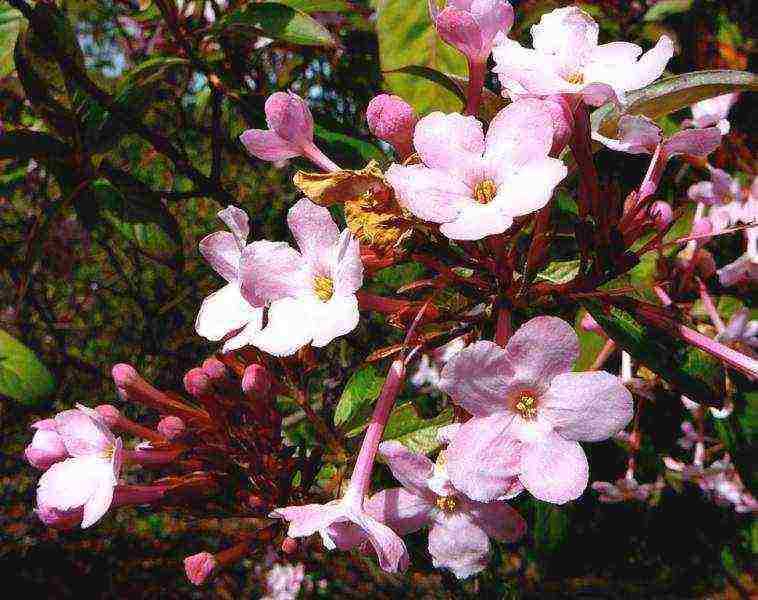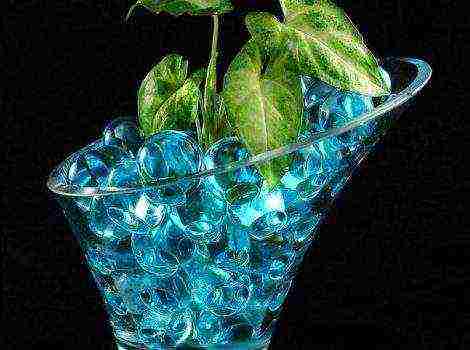Increasingly, residents of cool regions are trying to grow exotic flowers on their windowsills, in home greenhouses and winter gardens.
It is especially pleasant to admire your blooming garden in late autumn and winter.
As if summer outside the window and a bright flower bed simply moved from the dacha to the house.
One of these plants is Luculia (Luculif gratissima) from the Madder family. In nature, it is a rare beautifully flowering shrub, reaching a height of 6 m. In the southern regions, it blooms in the open field.
In the conditions of an apartment, Luculia grows well, subject to certain agrotechnical techniques. The flowering time is different for different varieties. The most beautiful and fragrant plants that bloom in winter.
The flower inflorescences are similar to phlox and smell very nice. During the budding period, the bushes resemble white and pink clouds against the background of graceful elliptical emerald leaves.
Growing luculia
Location and lighting
Luculia does not like bright long-term lighting. It grows well in partial shade. The light should be diffused without direct sunlight.
It is not advisable to place flower pots on southern windowsills and next to powerful winter heating.
Temperature
A moderate temperature all year round is required for abundant flowering. In winter, its optimum value is about 15 ° C.
Watering and humidity
During the summer, water the plant abundantly every 3 to 4 days. On hot days and at the beginning of the heating season, it is necessary to spray in addition to watering.
It should be done early in the morning before the onset of heat or late in the evening. Luculia should not be overdried, but at the same time, with an excess of water, root decay quickly occurs.
If water gets on the leaves frequently, they can also rot. In winter, you can not feed and water often. Otherwise Luculia will not bloom.
The appearance of brown spots on the leaves indicates sunburn. To eliminate this negative factor, you need to rearrange the pot away from the window glass.
Fertilizers
Top dressing of Luculia is carried out only during the period of active growth 1-2 times a month with complex fertilizers for indoor plants.
Transplant and reproduction
Reproduction of Luculia is possible by cuttings and seeds. Getting a good handle is not easy. This rare plant is easier to obtain from amateur flower growers than in stores.
Growing from a cuttings is not difficult. But the choice of seeds is huge and you can try to grow this flower yourself.
The main thing is to correctly fulfill all the requirements for working with seeds of tropical plants. And then you can observe, rejoice and be surprised at all the phases of development of this exotic plant.
There are no special requirements for the soil for planting. You can use ready-made soil mixtures for beautifully flowering plants.
Good drainage is essential. Only young plants are transplanted annually. This should be done carefully without disturbing the root system once again. Better by transferring to another pot.
After the end of the flowering period, it is imperative to cut off the shoots. The bush will become not so high, but more compact and beautiful, creating coziness and special tropical warmth in the house.
Share with your friends on social networks
Luculia gratissima
In chapter Houseplants to the question Has anyone grown Luculia gratissima at home? How does it come up? given by the author *@ Ekaterina @ * the best answer is The genus Luculia includes 5 species of evergreen shrubs found in mountainous areas. The genus name Luculia comes from the Latinized Nepalese folk name "luculi swa". Besides L. gratissima, L. grandifolia, with more attractive foliage and white flowers, and L. intermedia with pink flowers, similar to the two mentioned, are also common.
This beautiful evergreen shrub in nature can reach a height of 6 m, in gardens they usually maintain a height of about 3 m, and an even more compact plant is grown in a container at home. The bush is covered with rounded, almost leathery leaves, pubescent on the back, and is characterized by uneven growth, so pruning is used to shape it.
Gorgeous pale pink flowers, collected in luxurious clusters up to 20 cm in diameter, appear at the ends of branches in autumn and winter, and the delightful aroma emanating from them is a cross between the smells of gardenia and vanilla. It is no coincidence that the species received this very Latin name (gratissima - very pleasant). Flower brushes resemble phlox.
Luculia grows well in light partial shade with several hours of morning or evening sun. In direct sun shading is required at noon hours. She does not like overheating of the root system, so the pots must be shaded with light material or arranged in such a way that they are in the shade.
The soil mixture must be well drained, water and air permeable. Drainage is required, you can pour expanded clay or small pieces of polystyrene on the bottom of the pot. Watering is moderate. Luculia does not like overdrying, and when it is flooded, rotting of the root system can begin. If water gets on the flowers, they can rot. It is not recommended to disturb the roots once again, but to do the transshipment; plant seeds immediately in small pots.
Luculia tolerates pruning well. After flowering, the plant can be cut quite strongly, this stimulates the growth of young shoots, on which flowers will appear in winter. Pruning also helps maintain the shape of the bush.
Seeds germinate slowly and unevenly, within 1-2 months, in a loose substrate. The soil mixture must be well drained, water and air permeable. Drainage is required, you can pour expanded clay or small pieces of polystyrene on the bottom of the pot. Watering is moderate. Luculia does not like overdrying, and when it is flooded, rotting of the root system can begin. If water gets on the flowers, they can rot. It is not recommended to disturb the roots once again, it is better to do the transshipment; plant seeds directly in small pots.
Family... Madder.
Origin... East Asia and Himalayas
 Description... Small genus "luculia“, Consists of 5 species of evergreen and deciduous, flowering shrubs or small trees. The leaves are large - 20 - 35 cm long, elliptical, soft, arranged in opposite pairs. Large inflorescences - umbrellas up to 20 cm in diameter appear on the tops of the stems and consist of many flowers. The flowers are fragrant, pink, lilac or white, with a long, thin floral tube. The scent of the flowers is reminiscent of gardenia or vanilla.
Description... Small genus "luculia“, Consists of 5 species of evergreen and deciduous, flowering shrubs or small trees. The leaves are large - 20 - 35 cm long, elliptical, soft, arranged in opposite pairs. Large inflorescences - umbrellas up to 20 cm in diameter appear on the tops of the stems and consist of many flowers. The flowers are fragrant, pink, lilac or white, with a long, thin floral tube. The scent of the flowers is reminiscent of gardenia or vanilla.
Height... Up to 6 meters in natural environment, in room culture is regulated by pruning.
Luculia - home care
Temperature conditions... The flowering period will be longer if the lukulia is kept cool - with a temperature below 16 °. However, it is difficult to maintain this temperature indoors. At a temperature of about 20 °, flowering will last 3 - 4 weeks maximum. In winter, during dormancy, keep the plant at a temperature of 4 to 7 ° C, while ensuring very good air movement and gradually increase the temperature of the content with the appearance of new growth.
Lighting... Luculia needs a well-lit place without the scorching rays of the sun. When kept outdoors in summer and spring, the plant is placed in partial shade.
Care... ... The root collar of the plant should not be exposed to direct sunlight. Keeping lukulia indoors is not as difficult as it might seem. After flowering, the stems are cut to 1/3 of the length. In order for the plant to look more dense, young shoots are pinched just above the first pair of leaves.
Substrate... Well-drained, nutritious and loose, a mixture of heather, peat and coarse sand will work to improve drainage. pH from 6 to 6.5.
Top dressing... During the period of active growth, 2 times a month. Feed plants grown in acidic soil with heather fertilizer.
Appointment.
Flowering time... May June.
Air humidity... It quite calmly tolerates dry air of living quarters.
Soil moisture... During growth and flowering, abundant and regular watering is necessary. The soil must always remain moist. If luculia is grown in an acidic substrate, use soft water for irrigation. From late autumn, the frequency of watering is reduced.
Transfer... Luculia is transplanted in January or February. In large specimens, the top layer of soil is changed to a fresh one annually ..
Reproduction... Propagated by cuttings 10-15 cm long in June or July, rooting them in water. Each cutting should have at least 2 pairs of leaves and an apical bud, remove the lower pair of leaves. Dip the lower end of the cutting into the rooting preparation. Cover the planting with a plastic cap or bag to maintain moisture levels. After 3 weeks, remove it and water the plants regularly. Seeds.
Pests and diseases... Flowers and leaves dry out when water is scarce. Submerge the potted plant in water for 3 minutes and let the water drain. With a lack of light, the leaves turn yellow. Chlorosis can develop due to watering with too hard water. The plant stops growing when there is a lack of nutrients. From pests appear nematodes, red spider mites, aphids.
Note... Potted luculias can live 3-4 years in the house. The main difficulty in keeping is to provide the plant with a cool dormant period with constant ventilation.
Hydroponics.
You may also be interested in:
- Luculia grandiflora (Luculia grandiflora)
Shrub with upright branchy stems. The leaves are large, up to 20 cm long, elliptical, with depressed veins. Inflorescence is a compact raceme, close to an umbrella. The flowers are numerous, up to 3 cm in diameter, tubular at the base with a very wide, almost flat limb, light pink. Blooms in summer.
Luculia grandiflora is less popular than Luculia the nicest, but it can also be found quite often in home collections. Externally, the shrubs are similar, the only exception is the color of the flowers. The main difference lies in the timing of when the plant blooms, delighting with its magnificent appearance.
blooms in the second half of summer, usually before the beginning of autumn. The aroma of this species is weaker, but this does not affect the attractiveness of the plant.
When kept indoors, the plant will need more frequent spraying in order to provide the exotic beauty with the necessary moisture.
Luculia large-flowered in the warm season can be moved to a balcony or veranda. She feels more comfortable outdoors.
It differs primarily in the flowering time - the inflorescences of this species bloom in winter.


